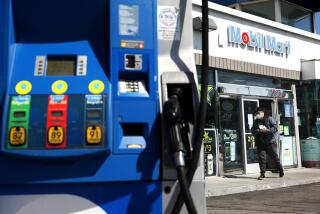Ethanol Appears to Fuel Profits More Than Conservation
- Share via
A federal push for cars that run on an alternative fuel straight from the heartland isn’t winning many converts among American drivers, but it’s a hit with automakers who use it to skirt mileage standards.
Five million cars across the country are equipped to run on the fuel, but almost no one uses it outside the Corn Belt.
Fortunately for carmakers, a 1988 law designed to decrease oil use gives them credits for building vehicles that run on the alternative fuel whether anyone uses it or not. Those credits allow automakers to relax gasoline efficiency standards on other vehicles -- which drives oil consumption up instead of down.
The situation would be different if more people replaced the gasoline in their tanks with the fuel known as E85 -- a combination of 15% gasoline and 85% ethanol, a corn-based additive. Flex-fuel cars can run on gas, E85, or combinations of the two.
Ethanol supporters say the extra oil consumption is part of the growing pains of the flex-fuels program, which they say will decrease oil use when more E85 fueling stations are available to drivers. “You’ve got to get the cars out before you can get the fueling structure,” said Tom Koehler, a spokesman for Fresno-based Pacific Ethanol.
A 2002 Department of Transportation study estimated that E85 accounted for 1% of the fuel consumed by flex-fuel vehicles between 1996 and 2000 -- the equivalent of 26 million gallons.
Relaxed fuel economy standards resulting from flex-fuel credits, meanwhile, were responsible for increased petroleum consumption totaling 772 million gallons -- enough gas for a Jeep Grand Cherokee to drive from San Diego to Boston and back more than 8,000 times.
Often cheaper than gasoline, E85 is known for getting fewer miles to the gallon but higher octane and more horsepower.
The fuel works in more than 30 models, including General Motors’ Yukon, Chevrolet’s Silverado and Ford’s Taurus, but many people don’t know it. Ford and GM have only recently begun national ad campaigns to promote their vehicles’ flex-fuel capabilities, trying to lure consumers skittish about gas prices.
Drivers can see if their vehicle will run on E85 by checking the owner’s manual or a website, e85fuel.com, that lists compatible models. Ethanol promoters say motorists are often stunned to learn their cars will run on the fuel, but even those well-schooled in E85 may need to drive hundreds of miles to buy it.
At the current Greater Los Angeles Auto Show, General Motors announced a partnership with Chevron, California officials and Pacific Ethanol to gauge the public’s interest in E85. Those involved said high interest could lead to more pumps nationwide.
The GM initiative is only a small step toward the kind of widespread E85 use that the flex-fuel credit program requires, said Roland Hwang, a senior policy analyst with the National Resources Defense Council.
“If this is the beginning and the end, this is less than a drop in the bucket,” Hwang said, adding that the incentive program should end if it continues to promote oil use.
With strong support from automakers, the incentives program was renewed in the sweeping energy bill President Bush signed in August.
Ethanol’s promoters call it a clean-burning fuel that helps farmers in the nation’s Corn Belt while reducing greenhouse emissions and reducing dependence on foreign oil.
“It’s 100% domestic,” said Phillip Lampert, executive director of the National Ethanol Vehicle Coalition. “We don’t have to fight wars to bring it in.”
Critics see the ethanol program as a waste of $3 billion a year in state and federal subsidies, pointing to a study last year by Cornell University and UC Berkeley that said ethanol takes more energy to make than it produces. Ethanol producers dispute the finding.
Only 30 states have public E85 fueling stations. Most are in the Midwest. California has only one, in San Diego.






